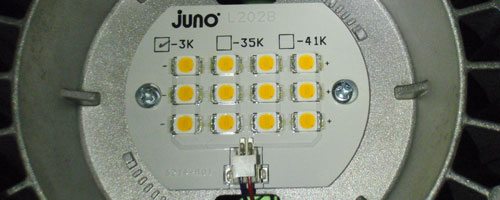
I do my best to be a steward of the environment through recycling, reusing, composting, minimizing fuel and electricity use when ever possible. As the story goes, this past year we purchased a new home in need of much updating and remodeling. My wife and I have taken it upon ourselves to integrate as much energy efficiency as we can into each remodeling effort. Our most recent home improvement project involved the complete gutting and redesigning of our kitchen area. Along with buying Energy Star appliances, installing a mountain of insulation, sealing every nook & cranny; we researched the most environmentally sound and energy efficient lighting technology available. Other than sunlight, the new LED technologies win hands down when compared to incandescent and compact fluorescent lights.
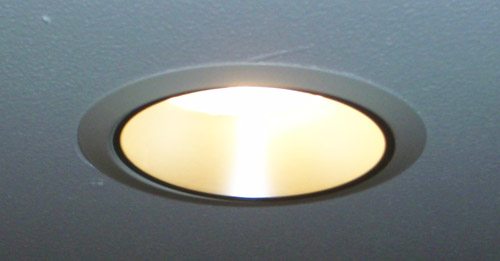
There are many LED bulbs available to retrofit a typical recessed (canned) light but only one (that I could find) that manufactures a true LED recessed light. The engineers at Juno have created a very well made light called the ‘Juno LED Downlight‘. Juno’s Downlight is the best made canned light I have ever seen and integrates several very high-tech features as well. And while these Juno LED lights are not a true gadget, LED lighting is a great use of new technologies to reduces your carbon footprint and electrical bills in the process.
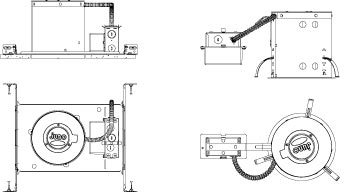
The Downlight is available in five and six inch housings and each size comes in new construction and remodel styles. Historically, the retrofit LED option did not provide enough light output and generated a good deal of heat.
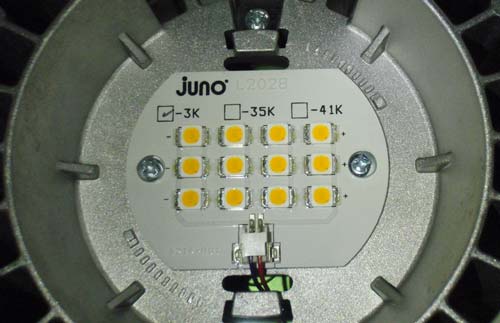
Juno has incorporated the latest generation Nichia high lumen LED light engines into the Downlight. Each size and style comes in three ‘flavors’ of light, 3000k, 3500k, and 4100k. These numbers are the temperature of the light itself. The lower the temperature the ‘warmer’ the light the LED gives off. The 4100k LED’s give off a much purer white light that I have read many think is too harsh. We went with the 3000k, 6 inch new construction Downlights and the lighting they produce is just what my wife and I were hoping for.

Installation of the Juno LED Downlight is no different that any other recessed lighting. My electrical buddy installed them quickly and easily.
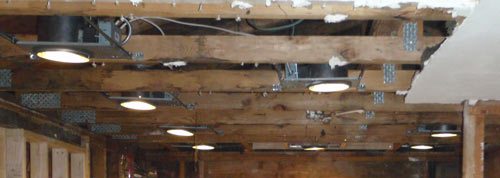
The only thing I was surprised about, is a one second (or there a bouts) delay between the flipping of the switch and the light coming on. I believe the delay is from the capacitor charging. One of the great features of the Downlight is that it can be controlled by a standard dimmer switch (something most retrofit LED bulbs cannot do).
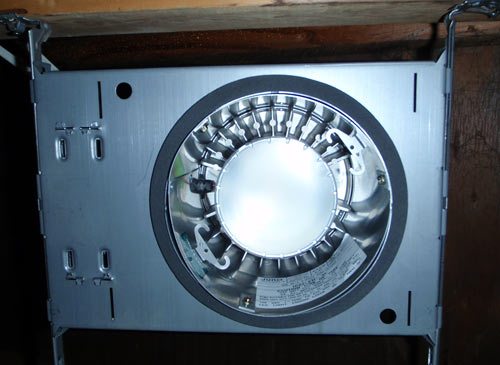
The cast aluminum heat sink is integrated directly into the housing providing excellent heat management/dissipation to ensure the long life of the LED and can be completely covered with insulation. The housing is engineered for use in IC (insulated ceiling) or non-IC construction and the .032” thick aluminum housing sealed for Air-Loc compliance. The LED is rated for at least 50,000 hours of use and produces 600 lumens using a mere 14 watts of energy. The point is that these and other LED based products use a tiny fraction of the energy and last several orders of magnitude longer than an equivalent incandescent light.

The Juno LED Downlight produces an excellent light, will last long after I am dead and gone, and use very little energy along the way (remember, every little bit helps 😉 ). However, I have to admit these lights are not cheap. Actually they are the most expensive recessed light I have ever purchased/seen. The cost of the Downlight at your average lighting store is over $200. But even at this high dollar price tag, these LED lights are in very high demand. At the time, I bought the last case of new construction 6″ 3000k in my end of town.
Gerber Gear Suspension 12-in-1 EDC Multi-Plier Multitool with Pocket Knife, Needle Nose Pliers, Wire Cutters and More, Gifts for Men, Camping and Survival, Grey
$58.99 (as of December 20, 2025 18:01 GMT -05:00 - More infoProduct prices and availability are accurate as of the date/time indicated and are subject to change. Any price and availability information displayed on [relevant Amazon Site(s), as applicable] at the time of purchase will apply to the purchase of this product.)Gerber Gear Diesel Multitool Needle Nose Pliers Set, 12-in-1 EDC Multi-Tool Knife, Survival Gear and Equipment, Black
$129.99 (as of December 21, 2025 03:39 GMT -05:00 - More infoProduct prices and availability are accurate as of the date/time indicated and are subject to change. Any price and availability information displayed on [relevant Amazon Site(s), as applicable] at the time of purchase will apply to the purchase of this product.)Product Information
| Price: | $165-210 |
| Manufacturer: | Juno |
| Pros: |
|
| Cons: |
|



Gadgeteer Comment Policy - Please read before commenting
Love that your diverse enough to include the downlight. I love everything LED. And it is a gadget.
One question, while the LED’s are rated at 50,000 hrs, I am curious about the longevity of the solder joints though. Does the manufacturer give a lifecycle figure on the circuits controlling the LED’s?
Still like them very much though.
Alan
Correct me if I’m wrong here, but these are complete lighting units, not something that you can screw into an exisiting standard fixture, right?
aphid: That’s correct, although we’ve been contemplating recessed lighting in the living room. I wonder if these are any more difficult to install in a pre-existing ceiling than other models. I don’t really want to take the entire ceiling out like your kitchen re-model!
I do also wonder how the light “spread” is, we’ve put halogens into other rooms & I’m not very happy with how directional they are.
Are these cooler or hotter than regular incandescent can bulbs?
@John This is totally off topic… but is your avatar Robert Johnson? If so, I love his stuff. 🙂
John – LEDs run cooler than incandescents. That is where the energy is saved, not heating your house. Many folks are confused about “color temperature” the 3000K number is not a heat value. It is how hot a chunk of carbon has to be to glow that color.
One other minor note – there are many recessed cans in LED, not just Juno. All the big names in lighting make one. There are also many upstarts and small companies doing a good job in LEDs. Retrofit lamps, something to screw in to existing fixures, are around but are not very practial yet. Personnally, I am waiting for the winner of the “L” prize by the Dept of Energy. http://www.lightingprize.org/
Shocking endorsement. My wife and I looked at these lights and were surprised at how little actual light they put out. The fine print in their
brochure shows 600 lumens. Correct me if I’m wrong but doesn’t a
60 watt light bulb produce around 850 lumens. This is kind of like a 40 or 50 watt light bulb. We figured we would have to buy almost twice as many of these fixtures to replace what we currently have in our kitchen to get the same amount of light. And at $200 bucks each, we walked.
There are in fact a number of LED recessed lighting fixtures now. See http://www.energystar.gov/index.cfm?fuseaction=ssl.display_products_com_html for a complete list of Energy Star-rated LED lights. Note the Energy Star sites shows wide differences between different manufacturers; while Juno’s 6″ fixture maxes out at 41 Lumens per Watt to produce a max of 603 lumens with 14 Watts, in comparison, Cree’s 6″ fixture maxes out at 61 (almost 50% more efficient) Lumens per Watt to produce between 663-673 (2700K or 3500K) with only 12 Watts. I have seen both company’s products and I prefer Cree’s color rendition and light distribution. Mark mentioned he saw Juno’s product at $200 each. Cree’s superior product can be had around the $110 price point. Google Cree LE6. I hope this helps out everyone looking for a greener product.
I just replaced 2, 8′ flourescent tube lights with 6, Commercial Electric T-64 LED light fixtures (each with 5 LEDs) installed in Halo cans, all of it purchased at Home Depot for less than $400. The lighting provided is an inoffensive white light, unaccompanied by heat or noise, that provides similar spread with the noisy, blinking, yellowish flourescents. The only problem with them is that we have not found a dimmer switch that will work.
Just read your article on the Juno lights and I am considering the IC20LED-3K. I think it is the 5″ version of the ones you purchased. I have one requirement, that they be able to dim to 5%. Most only dim to 20%. Do you know if these dim that far or how you can do it?
Thanks,
Bruce
They now make a 2700K lamp. I’m wondering how much of a difference this is from the 3000K? In your opinion.
How have your lamps held up?
We’re gutting our family room so I’m researching recessed lighting.
Even in 2011 most lighting stores have no clue about LED cans.
Why haven’t they caught on? Because regular cans are only $10?
Any advice you could offer would be greatly appreciated.
Hi Mike,
The Juno lights I installed/reviewed are still going strong. I haven’t had a single issue with them. As my wife and I plan to remodel the rest of our house, we plan to use these LED cans where ever we can.
The 2700K should be even warmer than our 3000K. I like the 3000K, definitely glad we did not use the 3500K or the 4100K variants.
I know they are expensive compared to regular canned lights but the Juno lights should last many, many times longer and be quantum levels greener as well.
Hope this helps,
Dave